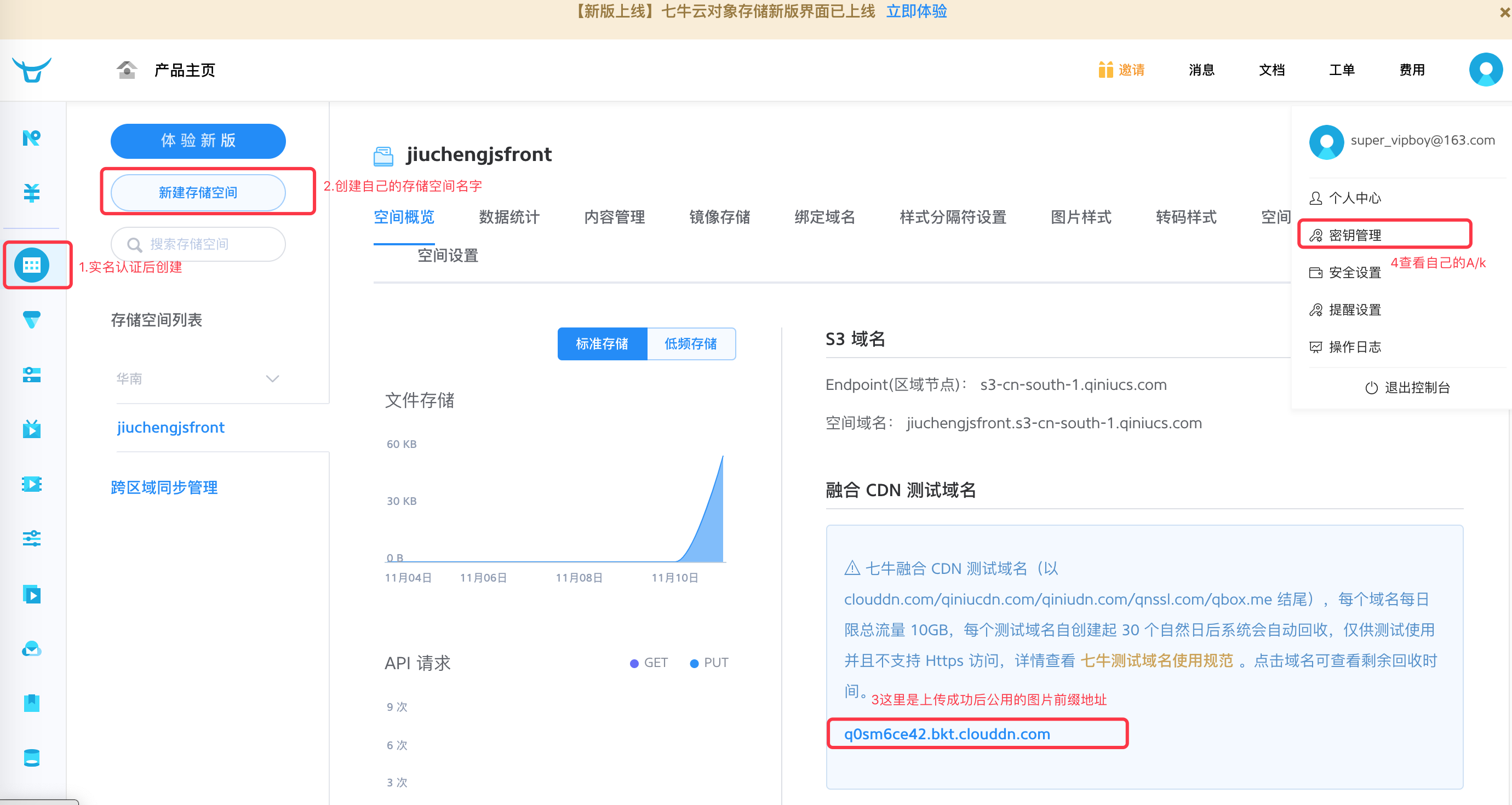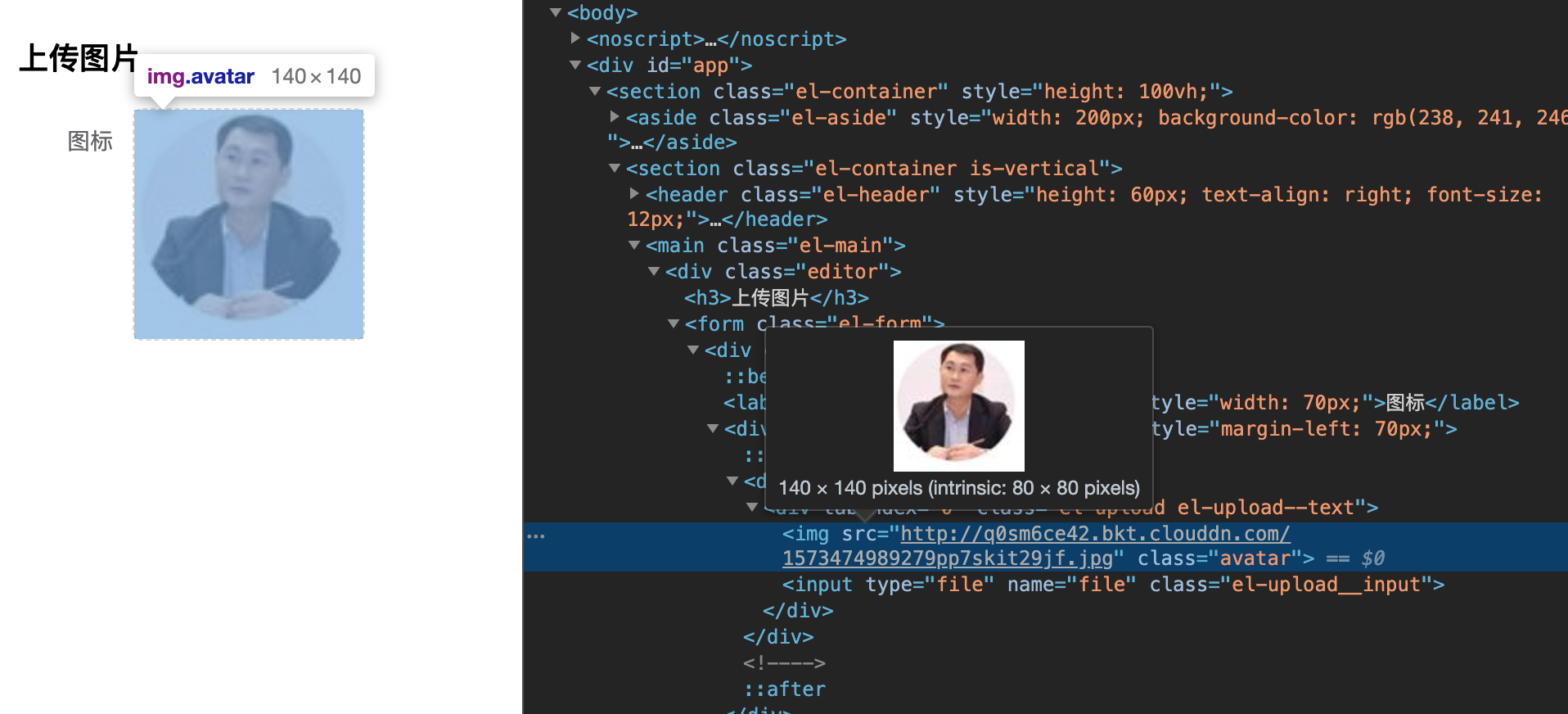Here are seven cattle cloud Element-ui Upload component in how to upload pictures of (free version, there are traffic restrictions)
First, the preparatory work
1. Sign up to seven cattle cloud account, and the real-name authentication, no authentication can not create storage space

2. Understand Element-ui component
Second, create the upload page (direct use here the official snippet)
<template> <div class="editor"> <h3>上传图片</h3> <el-form label-width="70px" @submit.native.prevent="save"> <el-form-item label="图标"> <el-upload class="avatar-uploader" :action="qiniuDomain" :http-request="upLoadToQiniu" :show-file-list="false" :before-upload="beforeUpload" > <img v-if="model.icon" :src="model.icon" class="avatar" /> <i v-else class="el-icon-plus avatar-uploader-icon"></i> </el-upload> </el-form-item> </el-form> </div> </template> <script> export default { data() { return {
upload address storage space created after the real-name authentication corresponding // (east, south, and so is not the same: https://developer.qiniu.com/kodo/manual/1671/region-endpoint ) qiniuDomain: " https://upload-z2.qiniup.com " ,
// create a public address prefix official pictures randomly assigned after successful that after a successful upload the corresponding public address prefixes Pictures qiniuViewHost: "http://q0sm6ce42.bkt.clouddn.com", model: { name: "", icon: "" } }; }, methods: { async upLoadToQiniu(req) { const config = { headers: { "Content-Type": "multipart/form-data" } }; let fileType = ""; if (req.file.type === "image/png") { fileType = "png"; } else { fileType = "jpg"; } // rename files to upload const KeyName = `$ { new new a Date () the getTime ().} {$ Math.random () toString (. 36 ) .slice ( 2 )} {$` fileType};. @ Upload time Token, can generate their own front-end, back-end to generate safe!
// this is the rear end of the express generated the Token const RES = the await the this $ http.get (. " / Token " ); const token = res.data.uploadToken; const formdata = new FormData(); formdata.append("file", req.file); formdata.append("token", token); formdata.append("key", keyname); const result = await this.$http.post(this.qiniuDomain, formdata, config); this.model.icon = `${this.qiniuViewHost}/${result.data.key}`; }, beforeUpload(file) { // debugger const isJPG = file.type === "image/jpeg" || file.type === "image/png"; const isLt10M = file.size / 1024 / 1024 < 10; if (!isJPG) { this.$message({ showClose: true, the Message: " upload pictures only JPG / PNG format! " , type: "error" }); } if (!isLt10M) { this.$message({ showClose: true, the Message: " Upload avatar picture size can not exceed 10MB! " , type: "error" }); } return isJPG && isLt10M; }, }, created() { // Other ajax } }; </script>
Third, upload certificate (Token) How to get: https://developer.qiniu.com/kodo/manual/1208/upload-token
// seven cattle cloud CDK official node.js const qiniu = The require ( 'qiniu' ); config const = { // Personal Center -> secret key management -> AccessKey "AK": "xxxxxx your own" , // personal center -> secret key management -> SecretKey "SK": "xxxxxx your own" , // Object storage -> name of the new storage space :( create your own space when the name), where I created is: jiuchengjsfront "Bucket": "jiuchengjsfront" } // This is returned to the client according to express defined interfaces: token app.get ( '/ ADMIN / API / token', the async (REQ, RES) => { const mac = new qiniu.auth.digest.Mac(config.AK, config.SK); const options = { scope: config.Bucket, expires: 3600 * 24 }; const putPolicy = new qiniu.rs.PutPolicy(options); const uploadToken= putPolicy.uploadToken(mac); res.send({ uploadToken }) })
May not get from the interface, define their own successful method. Do not expose to others safe
// seven cattle cloud CDK official node.js const qiniu = The require ( 'qiniu' ); config const = { // Personal Center -> secret key management -> AccessKey "AK": "Your own Accesskey" , // personal center -> secret key management -> SecretKey "SK": "Your own SecretKey" , // Object storage -> name of the new storage space when creating your own :( name) "Bucket": "jiuchengjsfront" } // official document: HTTPS: //developer.qiniu.com/kodo/manual/1208/upload-token const mac = new new qiniu.auth.digest.Mac (config.AK, config.SK); const options = { scope: config.Bucket, expires: 3600 * 24 }; const putPolicy = new qiniu.rs.PutPolicy(options); const uploadToken = putPolicy.uploadToken(mac); export default uploadToken // use the time to be replaced
formdata.append("token", uploadToken);
const result = await this.$http.post(this.qiniuDomain, formdata, config); this.model.icon = `${this.qiniuViewHost}/${result.data.key}`;
Fourth, after a successful upload, such as:

